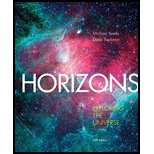
Horizons: Exploring the Universe (MindTap Course List)
14th Edition
ISBN: 9781305960961
Author: Michael A. Seeds, Dana Backman
Publisher: Cengage Learning
expand_more
expand_more
format_list_bulleted
Concept explainers
Question
Chapter 3, Problem 12RQ
To determine
The main characteristic of a pseudoscience and suggest other examples of it not described in the textbook.
Expert Solution & Answer
Want to see the full answer?
Check out a sample textbook solution
Students have asked these similar questions
(λvacuum =640nm)
red light
(λ vacuum = 640 nm) and green light
perpendicularly
on a soap film (n=1.31)
A mixture of
(a vacuum = 512 nm) shines
that has air on both side. What is the minimum nonzero
thickness of the film, so that destructive interference
to look red in reflected light?
nm
Causes it
Suppose the inteference pattern shown in the figure below is produced by
monochromatic light passing through a diffraction grating, that has
260 lines/mm, and onto a screen 1.40m away. What is the wavelength
of light if the distance between the dashed lines is 180cm?
nm
How many (whole) dark fringes will produced
on
on an
infinitely large
screen if red light (2)=700 nm) is incident on two slits that are
20.0 μm apart?
Chapter 3 Solutions
Horizons: Exploring the Universe (MindTap Course List)
Ch. 3 - What is the difference between the daily and...Ch. 3 - If Earth did not rotate, could you still define...Ch. 3 - What would the seasons be like if Earth were...Ch. 3 - Why are the seasons reversed in the Southern...Ch. 3 - Prob. 5RQCh. 3 - Do the phases of the Moon look the same from every...Ch. 3 - What phase would Earth be in if you were on the...Ch. 3 - Why have most people seen a total lunar eclipse,...Ch. 3 - Why isn’t there an eclipse at every new moon and...Ch. 3 - Why is the Moon red during a total lunar eclipse?
Ch. 3 - Why should the eccentricity of Earth’s orbit make...Ch. 3 - Prob. 12RQCh. 3 - Prob. 13RQCh. 3 - How Do We know? Why must a scientific argument...Ch. 3 - You are packing for a vacation on a planet...Ch. 3 - You happen to visit the Moon when some people on...Ch. 3 - Given that Earth is about 4.6 billion (4.6109)...Ch. 3 - Identify the phases of the Moon if on March 20 the...Ch. 3 - Identify the phases of the Moon if at sunset in...Ch. 3 - Prob. 4PCh. 3 - Draw a diagram showing Earth, the Moon, and...Ch. 3 - Phobos, one of the moons of Mars, is about 25 km...Ch. 3 - A total eclipse of the Sun was visible from Canada...Ch. 3 - Prob. 8PCh. 3 - The cartoon in Figure UN 3-4 shows a crescent...Ch. 3 - The photo in Figure UN 3-5 shows the annular...
Knowledge Booster
Learn more about
Need a deep-dive on the concept behind this application? Look no further. Learn more about this topic, physics and related others by exploring similar questions and additional content below.Similar questions
arrow_back_ios
SEE MORE QUESTIONS
arrow_forward_ios
Recommended textbooks for you
 Glencoe Physics: Principles and Problems, Student...PhysicsISBN:9780078807213Author:Paul W. ZitzewitzPublisher:Glencoe/McGraw-Hill
Glencoe Physics: Principles and Problems, Student...PhysicsISBN:9780078807213Author:Paul W. ZitzewitzPublisher:Glencoe/McGraw-Hill Principles of Physics: A Calculus-Based TextPhysicsISBN:9781133104261Author:Raymond A. Serway, John W. JewettPublisher:Cengage Learning
Principles of Physics: A Calculus-Based TextPhysicsISBN:9781133104261Author:Raymond A. Serway, John W. JewettPublisher:Cengage Learning Horizons: Exploring the Universe (MindTap Course ...PhysicsISBN:9781305960961Author:Michael A. Seeds, Dana BackmanPublisher:Cengage Learning
Horizons: Exploring the Universe (MindTap Course ...PhysicsISBN:9781305960961Author:Michael A. Seeds, Dana BackmanPublisher:Cengage Learning Physics for Scientists and Engineers: Foundations...PhysicsISBN:9781133939146Author:Katz, Debora M.Publisher:Cengage Learning
Physics for Scientists and Engineers: Foundations...PhysicsISBN:9781133939146Author:Katz, Debora M.Publisher:Cengage Learning An Introduction to Physical SciencePhysicsISBN:9781305079137Author:James Shipman, Jerry D. Wilson, Charles A. Higgins, Omar TorresPublisher:Cengage Learning
An Introduction to Physical SciencePhysicsISBN:9781305079137Author:James Shipman, Jerry D. Wilson, Charles A. Higgins, Omar TorresPublisher:Cengage Learning University Physics Volume 1PhysicsISBN:9781938168277Author:William Moebs, Samuel J. Ling, Jeff SannyPublisher:OpenStax - Rice University
University Physics Volume 1PhysicsISBN:9781938168277Author:William Moebs, Samuel J. Ling, Jeff SannyPublisher:OpenStax - Rice University

Glencoe Physics: Principles and Problems, Student...
Physics
ISBN:9780078807213
Author:Paul W. Zitzewitz
Publisher:Glencoe/McGraw-Hill

Principles of Physics: A Calculus-Based Text
Physics
ISBN:9781133104261
Author:Raymond A. Serway, John W. Jewett
Publisher:Cengage Learning

Horizons: Exploring the Universe (MindTap Course ...
Physics
ISBN:9781305960961
Author:Michael A. Seeds, Dana Backman
Publisher:Cengage Learning

Physics for Scientists and Engineers: Foundations...
Physics
ISBN:9781133939146
Author:Katz, Debora M.
Publisher:Cengage Learning

An Introduction to Physical Science
Physics
ISBN:9781305079137
Author:James Shipman, Jerry D. Wilson, Charles A. Higgins, Omar Torres
Publisher:Cengage Learning

University Physics Volume 1
Physics
ISBN:9781938168277
Author:William Moebs, Samuel J. Ling, Jeff Sanny
Publisher:OpenStax - Rice University